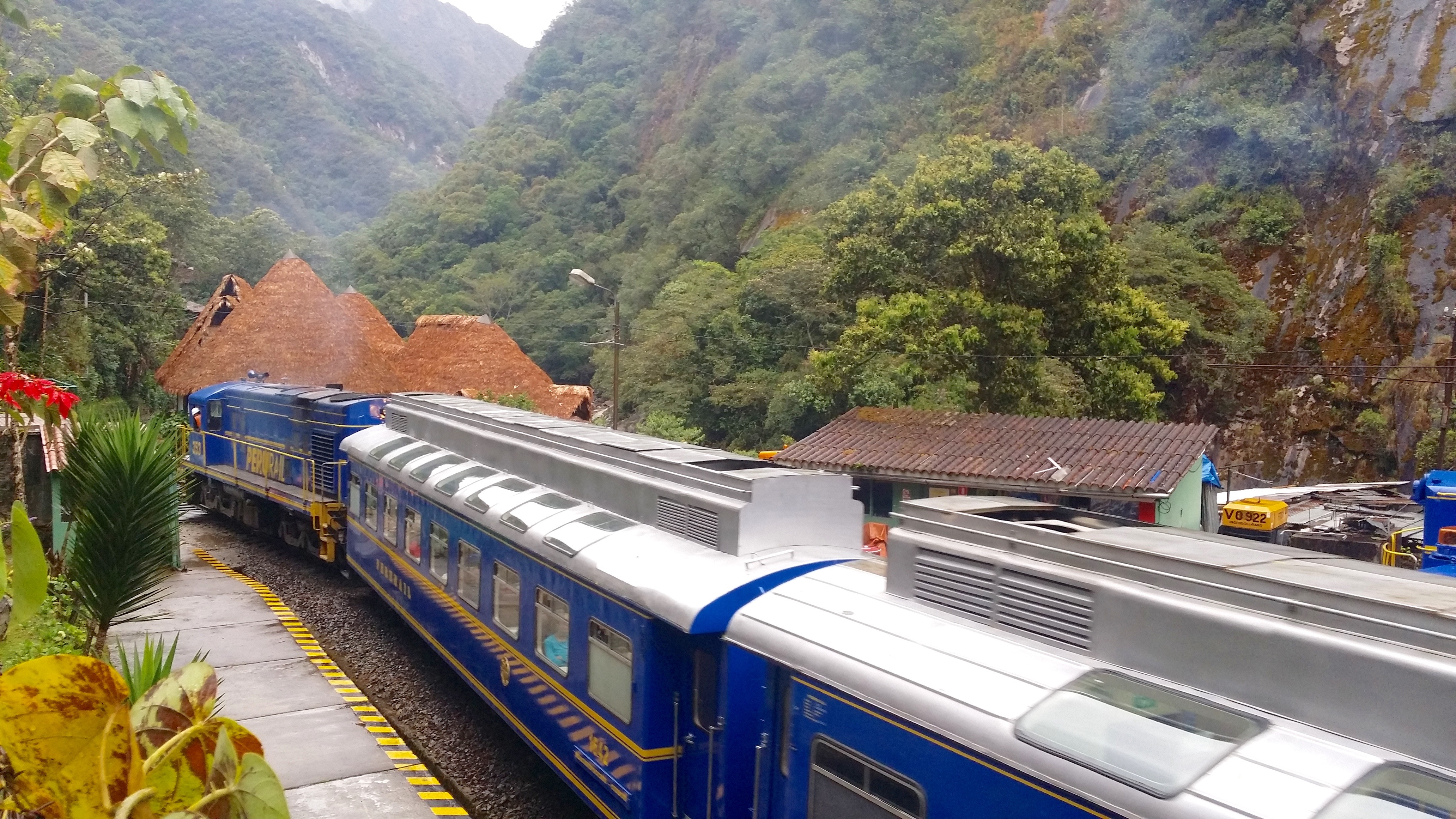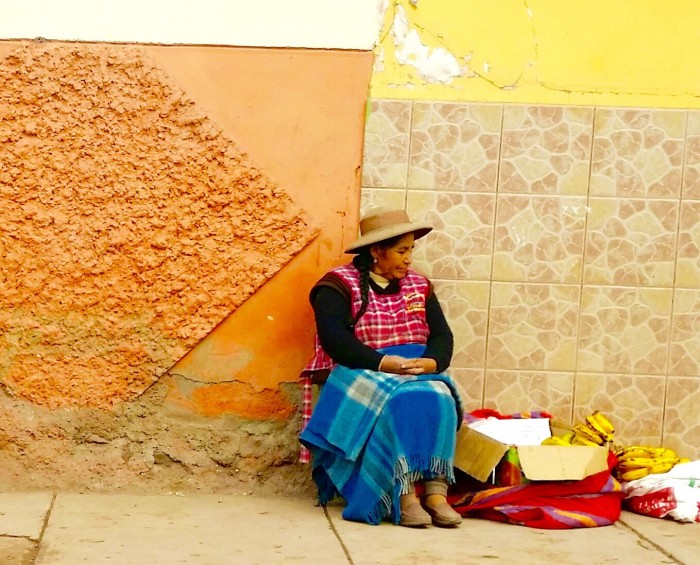There is a beautiful feeling of serenity at the spectacular former Incan city of Machu Picchu. The long road through the Andes to this remote paradise is not so well acclaimed, but is also very special. This is a journey unlike any you will ever have undertaken before, and it will stay with you forever. Getting to the jewel of the Sacred Valley can be costly and time consuming, but it is a journey which is to be enjoyed rather than endured. This is my 6-part travelogue, revealing the highlights of the road to Machu Picchu, including Ollantaytambo.
Ollantaytambo to Aguas Calientes
While the small but busy Sacred Valley town of Ollantaytambo is attractive on it’s own merits, with Inca ruins and riverside setting, one amenity above all others attracts many of the visitors who pass through here; the train station.
Unless you were to go off-grid and (attempt to) hike over the towering Andes mountains, there is but one way to get to Machu Picchu; by first making the journey from Ollantaytambo to Aquas Calientes by train. Considering that up to 5,000 visitors filter through Machu Picchu on a busy day, Ollantaytambo is a very busy little place. The entire town is like a cross between a mini Machu Picchu, a souvenir shop, a cargo hanger and a travel rep’s office. Everybody, and everything that goes to Machu Picchu, must pass through here – including all food and provisions for Aguas Calientes.
We had arrived into the Sacred Valley by taxi from Cusco with just over 20 minutes to spare before our pre-booked train departure time. The road to the station, the limited drop-off point and the platform were crowded with tourists, bags, craft stalls, travel guides, goods transportation and train workers. It was a huge relief to finally board the train and find a seat. Around two minutes later, the whistle blew, and we were off!

Onboard the Inca Rail train
We were on board a train operated by Inca Rail, which had large carriage windows supplemented by overhead skylights. We were soon to discover why the rail company had the foresight to include the additional glass. As soon as we moved from the platform, we were immediately in the middle of a scenic river valley, the likes of which I have never seen before. On one side of the train, the fast flowing waters of the Urubamba River race right by the tracks, and on the other side, the tiny patchwork of fields very quickly give way to the sometimes almost vertical walls of The Sacred Valley. The views are simply spectacular.

Train from Ollantaytambo to Aguas Calientes

The tree-lined Urubamba River Valley
Everyone in our carriage was mesmerized by the passing scenery. Everyone that is except for a Brazilian tourist who was sitting on the opposite side of the table from me. Having seen my Tottenham Hotspur shirt, he was determined to strike up a soccer centered conversation. So much so, that he proceeded to lay the shirt of his preferred team out on the table, and insist that I photograph it, with said Brazilian beaming in the background. I obliged, and quickly returned to admiring the views. I love Tottenham, and soccer, but these views were too amazing to miss!

My Brazilian soccer friend
The train ride takes approximately 90 minutes, with the return leg lasting a full 2 hours. The additional 30 minutes can be accounted for by the fact that this is the Andes, and even though the train line is on what you would think is a relatively flat bed, Peruvian logic still holds true: when you are traveling you are either going uphill or downhill. We were currently moving downhill, following the banks of the Urubamba River. I tried to imagine how powerful the force of this water must be when the river is in flood.
I get a lot of thought stimulation from water, which I think is a welcome byproduct of my love of the ocean, waves and rugged coastlines. I see symbolism in water, and it really helps me to become aware of the present moment. So it occurred to me, that this part of the river valley would often suddenly experience a raging torrent, even if it had not rained in this particular section. The flood would quickly arrive from upstream. I reasoned that in life, the same scenario can occur. In a butterfly effect, even if we are serene and calm ourselves, someone else’s actions can send a sudden and unexpected torrent our way. Just as the people in The Sacred Valley have strategically placed boulders by the banks while the water was low, preparing in advance of the flood, we too can brace ourselves by building strong defenses when there is calmness. Knowing ourselves, and understanding our reactions is one of the keys to wellbeing. Often, our troubles can come not from our own actions, but from our reaction to someone else’s action. At that moment, upon such a realization, I felt completely at peace. Somehow, the Urubamba River had shown me how to be focused and aware, how to enjoy this moment, yet to use this peaceful time to ensure that I would completely enjoy Machu Picchu.

Traveling by train deep into the wilderness
The sides of the valley are as fascinating as the river itself. Having approached from Cusco, we had traversed agricultural uplands. But now we had entered into a region of Peru which has more in common with the Amazonian jungle terrain on the other side of the Andes. The steep walls of the valley are almost completely covered with tress, resulting in the sharpest gradient of leafy canopy imaginable. Sporadic clouds hover overhead; high above the train, yet still a long way beneath the snow capped peaks of the surrounding mountain range.

Inca Rail en route to Machu Picchu
Down and around we went, steadily venturing deeper and deeper into the very heart of this timeless terrain, moving further away from the busy world. I pondered what this journey must have been like in previous centuries. It is little wonder that Machu Picchu remained unseen during the Spanish Conquistador’s foray into this region of South America. The valley walls are impossibly steep. In the days before planes and railways, even if for some reason the Spanish had decided to trek all the way along this bank, or raft down the river itself, Machu Picchu would not have revealed itself. The walls supporting the Inca city look just like the walls all along the entire journey. Furthermore, the terraced nature of Machu Picchu’s construction means that from up high, the river is clearly visible, but from the depths of the river valley looking upwards, Machu Picchu, blends into the wilderness like a chameleon.

Small potato field by the rail track
Even Hiram Bingham, the inquisitive American academic who finally discovered Machu Picchu and revealed it’s secret’s to the world in 1911, was apparently only able to do so having first being given guidance by indigenous farmers. The topography along the train road from Ollantaytambo to Aguas Calientes, gives a strong demonstration of just how well the Inca’s chose this now famous, but once hidden treasure.

Table service onboard Inca Rail
In a world apart from Bingham’s original travel experience, we meandered effortlessly down the valley while comfortably sitting on leather upholstered seats, availing of table service, affording us the opportunity to fully marvel at this unique adventure. The train ride perfectly sets the tone for a visit to Machu Picchu. You cannot help but dream of hidden worlds and lost treasures. The clickety-clack of the train passing over the sleeps and the amazing scenery seemed to cast a mystical spell over all on board. Time seemed to both stand still, yet pass by too quickly.
There is little in the landscape to signal the approach to the end of the line at Aguas Calientes. The town clings tightly to steep ground which is much like the rest of the valley. As the train slowed on approach, I looked through the open window to survey what lay ahead. A simple but distinctive grass roofed cafe greeted our arrival at this quaint, busy, yet very welcoming station and town. As the train finally came to a stop, my emotions were happiness, excitement and relief. I had arrived!

Distinctive grass roofed cafe at the station
Much like my fellow European explorers several centuries before me, I still had no idea where Machu Picchu was. But I knew I was close. So close now in fact, that the list of possible yet unlikely events which could have derailed this amazing trip, had now shortened considerably.
Stepping from the train onto the Aguas Calientes platform, you do so in the knowledge that you are now only one night’s sleep and a short, but ultimately very steep, bus ride away from one of the most beautiful places in the whole world. Gratitude now prevailed.
Have you read the other posts in this series?
Part 1: Arequipa
Part 2: Arequipa to Cusco
Part 3: Cusco
Part 4: Cusco to Ollantaytambo









